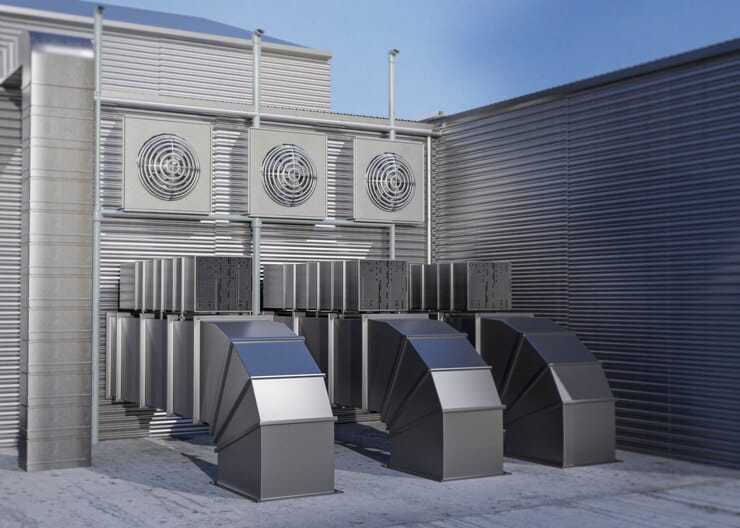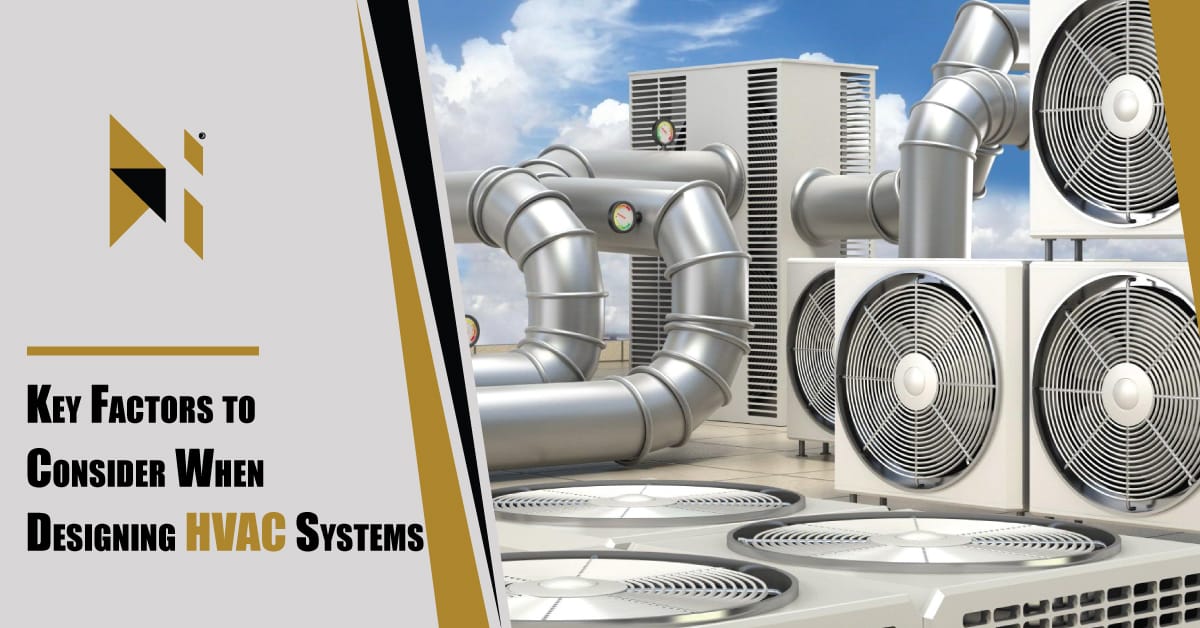Designing HVAC or an effective HVAC (Heating, Ventilation, and Air Conditioning) system is essential for ensuring comfort, energy efficiency, and air quality in both residential and commercial buildings. HVAC systems are responsible for regulating temperature, humidity, and air circulation, making them crucial for creating a comfortable and healthy indoor environment. However, designing these systems involves more than just choosing equipment; it requires careful planning, precise calculations, and adherence to industry standards.
Several key factors must be considered during the design phase. Energy efficiency is a primary concern, as it not only impacts operational costs but also aligns with growing environmental and regulatory demands. Accurate load calculations are equally important to avoid under- or over-sized systems, which can lead to inefficiencies, discomfort, and increased costs. Additionally, maintaining good indoor air quality is crucial for the health and well-being of building occupants, which requires attention to ventilation, filtration, and humidity control.
Compliance with local and international standards, such as ASHRAE or other relevant guidelines, is also critical to meet safety and quality requirements. By addressing these factors, designers can create HVAC systems that not only deliver consistent performance but also support sustainability and long-term cost savings.
Importance of designing an HVAC system
It is an essential viewpoint to consider while planning warming, ventilation, and cooling frameworks. There ought to be an emphasis on grasping structure necessities. It incorporates considering the size and design of the space where the framework will be introduced. The designer works out the prerequisites of the structure and uses them to give a superior arrangement. There are various kinds of spaces, similar to enormous open office spaces, with various cooling needs. Multi-story structures have various requirements for it. The environment zone and neighborhood weather patterns ought to likewise be considered. Mechanical architects cautiously gauge the accessible space and plan the framework for legitimate wind current and better temperature and indoor air quality upkeep.

Types of HVAC systems
There are some common types of HVAC systems. These types include,
- Split system for residential buildings
- hybrid split systems with more energy efficiency with electric and gas options
- Duct-free systems for buildings without ductwork
- packaged systems for small commercial spaces
- Variable air volume systems for large commercial buildings
- chilled water systems for office towers and shopping malls
Key Factors to Consider
Health And Safety Requirements
Appropriate ventilation is the need to offer clean air in an indoor climate. Eliminating toxins and other destructive substances should be appropriately arranged. It additionally controls the mugginess levels and evades the entry of unsafe substances like carbon monoxide. The arrangement should consider introducing a legitimate air filtration framework to give a superior ventilation framework.
Energy Efficiency
Supportability and energy proficiency are the premier standards in planning an air conditioning system in present-day green structures. Flexible practices enormously diminish energy utilization and keep up with lower utility expenses. This likewise lessens natural consequences for carbon emissions to advance a green climate. To enhance the usefulness, the modelers plan and plan energy-effective frameworks with maintainable hardware like savvy indoor regulators, high-productivity heat siphons, and variable refrigerant stream frameworks.
Ducts And Ventilation
While planning a framework, you ought to consider the legitimate establishment of ventilation work. Configuration as per the size, protection, and conduit with legitimate air dissemination dispersion. Channels and ventilation should be appropriate for outside air admission and depleted to keep up with amazing indoor air quality. The architect ought to involve the accepted procedures for channel plan and establishment. Wind stream appropriation and cooling loads are additional considerations. Building size, region, direction, and protection all in all decide load computation necessities. Ideally, let’s consider the cooling load while planning it.
Building Size and Design
The size and configuration of the structure are essential factors that impact the air conditioning framework plan. The absolute area, number of floors, and room setups decide the total computations needed to determine the framework’s limit necessities. Precise estimations and evaluation of the structure’s qualities are fundamental for fair measuring and drafting the central air framework, which our professionals are competent at.
System Integration
Likewise, anticipating better framework combinations ought to be thought of. The framework ought to be associated with the structure of the computerization framework for unified control. It additionally upholds observing and enhancing the energy levels and controlling the energy use and execution. The arrangement ought to incorporate the framework with cutting-edge mechanical arrangements and gadgets. Numerous business structures and shopping centers introduce brilliant gadgets to interface with the frameworks. The warming, ventilation, and cooling frameworks should be viable and complete to the point of associating with the most recent gadgets and shrewd frameworks.
Air Distribution
Think about appropriate drafting to work in various structure regions for warming and cooling capabilities. You ought to plan a fair air dissemination framework for legitimate wind current flow and temperature control in all space regions. The framework should satisfy the structure needs, utilizing the heap computation to help. Construction standards give total direction to appropriate preparation.
Reliability
Commercial structures need reinforcement frameworks for consistent activities in the event of any disappointment in the framework or hardware. Likewise, think about this point while planning this framework. Try to plan with legitimate wellness norms. Suggest top-notch frameworks and gear for establishment. Top-quality equipment and surefire parts are the best answers for giving long-term usefulness and a long life expectancy for the framework and its hardware. Putting resources into the best-quality hardware and parts gets a good deal on harms and fixes.
Conclusion
Designing an effective HVAC (Heating, Ventilation, and Air Conditioning) system involves carefully balancing multiple key factors to ensure optimal performance, efficiency, and comfort. As we’ve discussed, considerations like energy efficiency, load calculations, indoor air quality, and system maintenance play crucial roles in creating an HVAC system that meets the specific requirements of the building and its occupants.
Energy efficiency remains one of the most critical aspects, as it directly impacts operational costs and environmental sustainability. Incorporating energy-efficient technologies, smart controls, and sustainable design practices can significantly reduce energy consumption and minimize environmental impact. Additionally, conducting accurate load calculations ensures that the HVAC system is neither undersized nor oversized, optimizing performance and avoiding unnecessary energy wastage.
Indoor air quality is another fundamental aspect, influencing the health and comfort of building occupants. Proper ventilation, the use of air filters, and humidity control are essential to maintain high air quality and a comfortable environment. Regular maintenance and monitoring of the system are also necessary to ensure consistent performance, prevent breakdowns, and extend the lifespan of the equipment.
Furthermore, adhering to local codes and standards ensures regulatory compliance and helps avoid legal issues and costly revisions. Consulting with experienced HVAC professionals and engineers throughout the design process can help anticipate challenges, optimize system design, and implement the latest innovations.
In conclusion, designing an efficient and effective HVAC system requires a holistic approach that considers energy efficiency, indoor air quality, system maintenance, and regulatory compliance. By carefully evaluating these factors and leveraging modern technologies, designers can create HVAC systems that deliver long-term benefits in terms of comfort, efficiency, and sustainability. In an era where energy consumption and environmental impact are under increased scrutiny, taking a thoughtful approach to HVAC design is essential for meeting both current and future needs.

